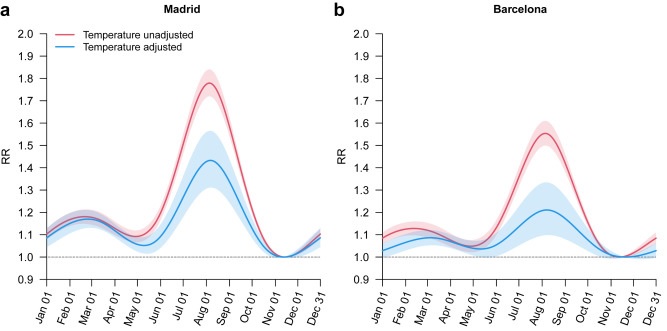Global warming caused by climate change could exacerbate the mortality burden of patients hospitalized for respiratory diseases during the warm season. This is the main conclusion of a study led by the Barcelona Institute for Global Health (ISGlobal), a center promoted by the "la Caixa" Foundation , and published in The Lancet Regional Health - Europe . The results could help health centers adapt to climate change.
A study analyzes the association between ambient temperature and hospital mortality due to respiratory diseases in the provinces of Madrid and Barcelona
The research team analyzed the association between ambient temperature and hospital mortality due to respiratory diseases in the provinces of Madrid and Barcelona between 2006 and 2019. In both locations, the number of hospital admissions (including those that caused death) was higher with the cold season and less in the warm season, with a peak in the month of January and a minimum in the month of August. Unlike hospital admissions, which were higher during the cold season, the peak incidence of inpatient mortality occurred during the summer and was strongly associated with high temperatures.
To calculate the association between ambient temperature and hospital mortality, the team used data on daily hospital admissions, climate (temperature and relative humidity) and air pollutants (O 3, PM 2.5, PM 10 and NO 2 ). Although it is well established that daily exposure to heat and cold is associated with an increased risk of hospital admission for a variety of respiratory diseases such as pneumonia, chronic obstructive pulmonary disease (COPD), and asthma, no study had focused on the proportion of hospitalized patients. admissions that result in death and, therefore, the most serious cases.

Figure: Seasonality of hospital mortality. RR = relative risk.
The link between high temperatures and mortality
In terms of attributable burden, summer temperatures accounted for 16% and 22.1% of total fatal hospitalizations due to respiratory diseases in Madrid and Barcelona, respectively. The effect of the heat was immediate and most of the impact occurred within the first three days of exposure to the high temperatures.
"This suggests that the increase in acute respiratory diseases during the heat is more related to the worsening of chronic and infectious respiratory diseases than to the spread of new respiratory infections, which usually take several days to cause symptoms," says Hicham Achebak, first author of the study. the study and researcher of Inserm and ISGlobal, who holds a Marie Skłodowska-Curie postdoctoral fellowship from the European Commission.
The results of the study showed an effect of heat on acute bronchitis and bronchiolitis, pneumonia and respiratory failure. Neither relative humidity nor air pollutants played a statistically significant role in the association of heat with mortality in patients admitted for respiratory diseases. The research also showed that women were more vulnerable to heat than men. “This is most likely due to specific physiological differences in thermoregulation. Women have a higher temperature threshold above which sweating mechanisms are activated, and less sweat production than men, which translates into less heat loss through evaporation and, therefore, greater susceptibility to the effects of heat," explains Joan Ballester, ISGlobal researcher and last author of the study.
Adaptation to climate change in hospital centers
The study shows that high temperatures contributed to an increased risk of fatal hospital admissions, especially in Barcelona, while low temperatures were not associated with this variable. According to the research team, this could have to do with the fact that health services are increasingly prepared to deal with winter spikes in respiratory diseases.
In this sense, the findings have important implications for health adaptation policies to climate change and for projections of the impact of climate change on human health. "Unless effective adaptation measures are adopted in hospital facilities, climate warming could exacerbate the mortality burden of patients hospitalized for respiratory diseases during the warm season," says Hicham Achebak.
Added value of this study
We show for the first time an inverse seasonal fluctuation between hospital admissions and mortality of patients hospitalized for respiratory diseases. Unlike hospital admissions, which are higher during the cold season, the highest incidence of in-hospital mortality occurred during the summer. We also showed that the peak in hospital mortality from respiratory conditions in summer was largely due to high temperatures. Furthermore, when analyzing the daily association between ambient temperature and hospital admissions resulting in death, we only found an effect for heat, thus confirming the results obtained in the seasonal analysis (i.e., higher incidence of mortality of patients hospitalized in summer ).
Implications of all available evidence
Unless effective adaptation measures are taken in hospital facilities, climate warming could exacerbate the mortality burden of patients hospitalized for respiratory diseases during the warm season.















